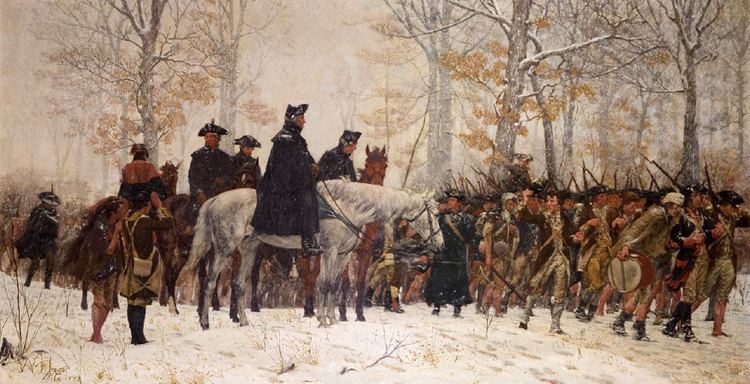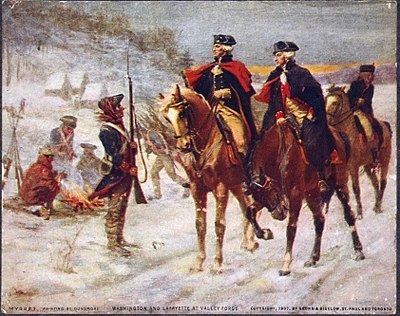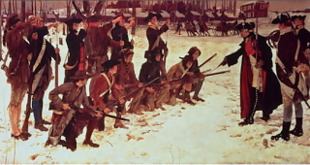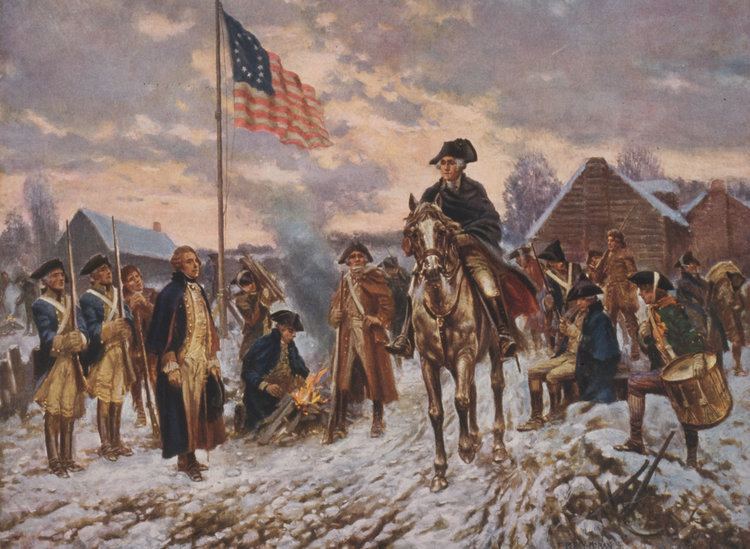Dates 19 Dec 1777 – 19 Jun 1778 | ||
 | ||
Result American Army survived a difficult winter | ||
Valley Forge was the military camp 18 miles northwest of Philadelphia where the American Continental Army spent the winter of 1777–78 during the American Revolutionary War. Starvation, disease, malnutrition, and exposure killed more than 2,500 American soldiers by the end of February 1778.
Contents
- 1 the difficult winter at valley forge
- Geography
- Shelter
- Food and supplies
- Hardships and supply shortages
- Restoration of army supplies
- Training
- Women and children
- Criticism of Washington
- Aftermath
- Baron Freiherr Friedrich Wilhelm von Steuben
- Oration by Henry Armitt Brown
- Valley Forge National Historical Park
- References

General George Washington sought quarters for his men with winter almost setting in, and with greatly diminishing prospects for campaigning. Washington and his troops had fought in early December what was the last major engagement of 1777 at the Battle of White Marsh (or Edge Hill). He devised to pull his troops from their present encampment in the White Marsh area (now Fort Washington State Park) and move to a more secure location for the coming winter.

1 the difficult winter at valley forge
Geography

Several locations were considered for the army's winter quarters, but Washington selected Valley Forge, Pennsylvania, 20 miles (30 km) northwest of Philadelphia. Valley Forge was named for an iron forge on Valley Creek in Whitemarsh, Pennsylvania. It was not the best place to set up winter camp for the Continental Army, as it was unable to defend southern Pennsylvania at the time. This location also left the vulnerable under-supplied army in striking distance of the British, who were well provisioned and secured in Philadelphia. The area was close enough to the British to keep their raiding and foraging parties out of the interior of Pennsylvania, yet far enough away to halt the threat of British surprise attacks.

The densely forested plateau of Mount Joy and the adjoining two-mile-long (3 km) plateau of Mount Misery made the area easily defensible, combined with the Schuylkill River to the north. It also provided abundant forests of timber that were used to construct thousands of log huts. Seventy-eight of the huts in the camp housed the soldiers, but more than 2,500 of those soldiers died.
Shelter
On December 19, 1777, Washington's poorly fed, ill-equipped army staggered into Valley Forge, weary from long marches. Winds blew as the 12,000 Continentals prepared for winter's fury. Only about one in four of them had shoes, and many of their feet had left bloody footprints from the marching. Grounds were selected for brigade encampments, and defense lines were planned and begun.
The first properly constructed hut appeared in three days. One hut required 80 logs, and timber had to be collected from miles away. It went up in one week with the use of only one axe. These huts provided sufficient protection from the moderately cold and wet conditions of a typical Pennsylvania winter. By the beginning of February, construction was completed on 2,000 huts. They provided shelter, but did little to offset the critical shortages that continually plagued the army.
Washington ordered that two windows should be cut into each hut during the springtime, as the climate grew considerably warmer. Mud was also chipped between the logs to improve ventilation.
Food and supplies
The soldiers received inadequate supplies of meat and bread, some getting their only nourishment from "firecake," a tasteless mixture of flour and water. Occasionally, there would be "pepper pot soup," a black pepper-flavored tripe broth. So severe were conditions at times that Washington despaired "that unless some great and capital change suddenly takes place... this Army must inevitably... starve, dissolve, or disperse, in order to obtain subsistence in the best manner they can."
Snow was limited and small in amounts. The layer of snow was often too thin to be collected and melted into drinking water. Alternating freezing and melting of snow and ice made it impossible to keep dry and caused disease to fester.
Animals fared no better. General Henry Knox, Washington's Chief of Artillery, wrote that hundreds of horses either starved to death or died of exhaustion. By the end of the winter, about 700 horses had died.
Washington appointed Nathanael Greene as Quartermaster General to take charge of the supplies, his ablest and most trusted lieutenant. In so doing, Washington signaled that the supply situation was a more serious threat to his army's survival than was Howe's army. Greene found caches of food and clothing and hauled them there for the troops and horses.
Clothing, too, was wholly inadequate. Many soldiers who were wounded from previous battles died from exposure. Long marches had destroyed shoes. Blankets were scarce. Tattered garments were seldom replaced. At one point, these shortages caused nearly 4,000 men to be listed as unfit for duty.
Hardships and supply shortages
The army was undernourished and poorly clothed, living in crowded, damp quarters, and ravaged by sickness and disease. Typhoid, typhus, smallpox, dysentery, and pneumonia were among the numerous diseases that thrived in the camp during that winter. These diseases contributed to the death of 2,500 soldiers by the end of the winter, along with malnutrition and exposure to the freezing temperatures and snow.
Gouverneur Morris of New York later stated that the Continentals were a "skeleton of an army...in a naked, starving condition, out of health, out of spirits."
Soldiers deserted in "astonishing great numbers" as hardships at camp overcame their motivation and dedication to fight. General James Mitchell Varnum warned that the desperate lack of supplies would "force the army to mutiny."
Women who were relatives or wives of enlisted men alleviated some of the suffering by providing valuable services that the army desperately needed, such as laundry and nursing. A group of people called Regimental Camp Followers also helped increase the morale of the soldiers and provided necessary support to the men.
Restoration of army supplies
Washington repeatedly petitioned for relief and supplies, but the Continental Congress was unable to provide it, and the soldiers continued to suffer. Finally, on January 24, 1778, five Congressmen came to Valley Forge to examine the conditions of the Continental Army. Washington greeted them imperatively, "Something must be done. Important alterations must be made." Washington also informed them that he wanted Congress to take control of the army supply system, pay for the supplies, and replenish them when necessities were scarce.
By the end of February, there were adequate supplies flowing throughout camp after Congress gave full support to monetarily funding the supply lines of the army, along with reorganizing the commissionary department, which controlled the gathering of the supplies for the army.
Training
Increasing military efficiency, morale, and discipline were as vital to the army's well-being as its supply of food and arms. The army had been handicapped in battle because unit training was administered from a variety of field manuals, making coordinated battle movements awkward and difficult. The soldiers were trained, but not uniformly. The task of developing and carrying out an effective training program fell to Baron Friedrich von Steuben, a skilled Prussian drill master who had recently arrived from Europe. He tirelessly drilled the soldiers, improving their battle and formation techniques greatly.
Women and children
George Washington's wife Martha arrived at the camp on February 10, 1778. She visited soldiers in the huts and in the camp hospital. She also organized a sewing circle of women who knitted, crafted, and patched socks, shirts, and trousers.
Camp followers at Valley Forge consisted of the wives, children, mothers, and sisters of the soldiers. These camp followers often served as laundresses, cleaning and mending the uniforms of the soldiers. Washington understood that a soldier would die quickly from disease if his uniform was dirty and threadbare. These women and children also provided the emotional support to the army, encouraging them to remain at camp and continue on training and soldiering during the winter months. Women gained half the rations of soldiers, half the wages of a soldier, and a half pension after the war—if they had done enough work. Children would receive quarter rations if enough work was done, although there is no documented evidence of this measure.
Women were relegated to the back of the column when marching and were forbidden to ride on wagons. Camp followers faced the issues of disease along with the soldiers. Women played an important role in scouting and finding supplies and food, and some lost their lives on the battlefield trying to obtain goods from wounded or dead soldiers. At Valley Forge, it is estimated that women averaged 1 to every 44 men, adding up to around 500 women, although there are no reliable figures for this number.
Criticism of Washington
The American public and Congress began to criticize Washington for his inability to advance the war effort, because of the terrible conditions of the army during the winter of 1777. Washington himself was aware of an increasing impatience and criticism of his leadership. A few soldiers wanted to replace him with General Horatio Gates, who had won a decisive victory in the Battles of Saratoga. Some members of the Continental Congress complained that Washington had left the surrounding countryside unprotected by moving into the isolated area of Valley Forge. Washington replied furiously:
Washington could not have launched any campaigns during the hardship at Valley Forge, yet anti-Washington movements still arose, led by Brigadier General Thomas Conway. These soldiers worked "behind the curtains" to degrade Washington's reputation in hopes that this would enable Horatio Gates to replace him as the commander of the Continental Army. This scheme is known today as the Conway Cabal.
Washington addressed them by saying:
This silenced his main critics and easily renewed his authority as the Commander-in-Chief of the Continental Army; his authority was never critically challenged for the rest of the decade.
Aftermath
After the horrendous winter, the Continental Army found out that France was going to aid their cause by sending military and monetary donations to the army. France had signed an alliance pact on February 6, 1778 with the 13 colonies, after General Horatio Gates's army had won the decisive Battles of Saratoga. A celebration of French alliance was organized on May 6, 1778 at Valley Forge. The army repeatedly shouted, "Long live France! Long live the friendly powers! Long live the American States!" Thousands of soldiers performed large drill formations and fired salutes from muskets and cannons. The formations were observed by George Washington and other military leaders. At the conclusion of the celebration, each soldier was to be rewarded one gill of rum.
Soon, word of the British departure from Philadelphia brought a frenzied activity to the ranks of the Continental Army. The army marched away from Valley Forge on June 19, 1778, exactly six months after they had arrived, and retook Philadelphia. They later charged in pursuit of the British, who were moving toward New York City. The Battle of Monmouth occurred on June 28, 1778 and resulted in an indecisive victory, though Congress and many newspapers treated it as an American victory, since the British retreated and left the battlefield first. This result demonstrated that the colonists were now able to withstand a strong British army after the intense training at Valley Forge under von Steuben, boosting morale and improving Washington's reputation as the Commander in Chief.
The winter at Valley Forge imbued into soldiers a strong will to persevere, endure, and triumph over obstacles and bring independence to the United States. Washington always acknowledged that the perseverance gained by the soldiers at Valley Forge was what made the Continental Army bind together even stronger and eventually win the war. At the same time, however, there were significant numbers of resignations among the officers. It was here, amid the struggles and trials, that Washington developed strong bonds of friendship with the much younger Lafayette.
Baron (Freiherr) Friedrich Wilhelm von Steuben
Von Steuben was a one-time member of the elite General Staff of Frederick the Great, King of Prussia. He was no longer in the Prussian Army—indeed, without employment of any kind—so he offered his military skills to the cause "without pay or rank," until he could prove himself.
He arrived at Valley Forge from France on February 23, 1778 with a letter of introduction from Benjamin Franklin. Washington saw great promise in the Prussian and almost immediately assigned him the duties of Acting Inspector General with the task of developing and carrying out an effective training program. He was a drill instructor who was full of energy. Von Steuben taught the soldiers how to aim muskets accurately, charge with bayonets, and maneuver together in compact ranks.
Numerous obstacles threatened success. No standard American training manuals existed, and von Steuben himself spoke little English. He trained the soldiers using German and French, along with some broken English, while Secretary Pierre Duponceau translated his orders into English. Undaunted, he drafted his own manual in French.
His aides often worked late into the night, translating his work into English, which was titled Regulations for the Order and Discipline of the Troops of the United States and more colloquially known as "The Blue Book." The translations, in turn, were copied and passed to the individual regiments and companies that carried out the prescribed drill or military parade the following day. "The Blue Book" remained the official American military training guide until the War of 1812.
Von Steuben shocked many American officers by breaking tradition to work directly with the men. One officer wrote of von Steuben's "peculiar grace" as he took "under his direction a squad of men in the capacity of drill sergeant." From dawn to dusk, his familiar voice was heard in camp above the sounds of marching men and shouted commands. Soon companies, regiments, and then brigades moved smartly from line to column, column to line, loaded muskets with precision, and drove imaginary redcoats from the field by skillful charges with the bayonet.
The Continental Army paraded on May 6, 1778 to celebrate the French alliance with America, and von Steuben received the honor of organizing the day's activities. On that day, the Grand Parade became a showplace for the united American army. Cannons boomed in salute. Thousands of muskets fired the ceremonial "feu de joie," a running fire that passed up and down the double ranks of infantrymen. Cheers echoed across the fields. The good drilling order and imposing appearance that the troops presented during the Alliance Day ceremonies demonstrated their remarkable progress in improving their abilities as a unified, fighting force capable of standing up to the British Army.
Washington had made a professional, disciplined, unified, and efficient army out of the Continental troops, with heavy aid from von Steuben. Von Steuben himself claimed that his "enterprise succeeded better than he had expected." With their French allies, the Americans could now proceed into the battlefield with hopes of winning the war, which raged on for many years.
Oration by Henry Armitt Brown
On June 19, 1878, author and orator Henry Armitt Brown delivered a speech to commemorate the hundredth anniversary of the departure of General George Washington's troops from the encampment at Valley Forge. His oration recalled the hardships suffered during the winter of 1777–78, while also celebrating the eventual victory of the Continental Army:
Brown's oration was published by J.B. Lippincott & Co. of Philadelphia in 1879, serving as a literary marker of Valley Forge's lasting impact upon American history and identity.
Valley Forge National Historical Park
Valley Forge National Historic Park commemorates the perseverance, sacrifice, and strength of the soldiers, the Continental Army, and the generals who were present during the winter of 1777–78.
The site of the encampment became a Pennsylvania state park in 1893 and, on the July 4, 1976, it became Valley Forge National Historical Park. The modern park features historical and recreated buildings and structures, memorials, and a visitor center which shows a short film and has several exhibits. Washington Memorial Chapel was built in 1904 as a memorial to Washington and his army. An adjoining carillon of 58 bells represents all U.S. states and territories. It resides in a tower underwritten by the Daughters of the American Revolution.
Other park amenities include walking and bicycle trails.
